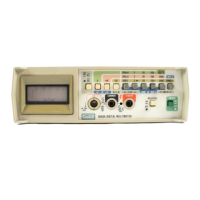OPERATION
RESISTANCE MEASUREMENT
EXAMPLE:
SRI
'>
...
AMMETER SHUNT
Es=
Source voltage
RI
= Load resistance + Source resistance
Im=
Measured current (display reading in amps)
Eb=
Burden voltage (calculated)
Eb=
meas. current [(200/current range in mA) +.35)
ERROR:
Error
in%=
100
x
Eb/(Es
- Eb)
Error in A = (Eb x lm)/(Es
- Eb)
Es=
15V
RI
= 100
kO
Im=
148.51
µA
(.14851
mA)
Eb=
148.51
x
10-
6
x [(200/.2) + .35)
=
148.51
x
10-'
x 1000.35 = 148.56 mV
Max. error
in%=
100 x [148.56
mV/(15V-
.14856V)) = 1.0003%
Add this to the range spec. accuracy:
Max. error
in%=
1.0003% ±(.2% + 2 digits)
Max. error in
A=
(148.56 mV x
148.51
µA)/(15000 mV - 148.56 mV)
= 1.486
µA
Add 1.486
µA
to the reading for correct
current
Figure 2-11. Calculating Burden Voltage Error
2-58. TEST LEAD COMPENSATION
2-59. When measuring low resistances (less than 2000)
the effect
of
test lead resistance may add a significant
error. This error may be compensated for by using the
relative function
of
the 8050A. Use the following
procedure to compensate for test lead resistance.
1.
Setup the 8050A as shown in Figure 2-5, steps 1
through
3.
2.
Short the test leads together (press the test leads
together firmly) and set the RELATIVE switch
to ON.
3.
Disengage the test leads and proceed with low-
level resistance measurements. The resistance
of the test leads will
be
subtracted from the
readings
of
subsequent measurements.
2-60. RESISTANCE COMPARISONS
2-61.
When one resistance value
is
needed for several
measurements (e.g. sorting resistors to find a matched
pair) the relative function
of
the 8050A can be used to
simplify the process. The following procedure
is
an
example of how the relative function may be used to
match resistors:
2-14
1.
Select the kO function on the 8050A.
2.
Select an appropriate range for the resistance
being matched.
3.
Measure the resistor.
4.
With the resistor value still displayed, set the
RELATIVE switch to ON.
5.
Measure the other resistors. Choose the resistor
with the least deviation from the resistor first
measured.
2·62. Conductance Measurement
2-63. The following paragraphs
contain
additional
information
on
and
measurement
techniques
for
conductance measurements.
2-64. HIGH RESISTANCE MEASUREMENTS
2-65.
The conductance function
of
the 8050A can be
used to measure high resistive (low leakage) components
(diodes and capacitors) while minimizing noise problems.
The two conductance ranges, 2
mS
and
200
nS, can be
used for making resistance measurements from
soon
to
10
MO
and 5 MO to 100,000 MO.
2-66. LEAKAGE RESISTANCE MEASUREMENTS
2-67. Use the
standard
conductance function for
leakage testing on purely resistive components (e.g.,
cables and pcb's). Remember to zero the display reading
with the relative function before taking conductance
measurements.
NOTE
Under high humidity conditions, finger prints
and
other residual surface contaminants can
create their own leakage paths.
Use
clean test
leads to minimize the effect
of
leakage paths.
.!

